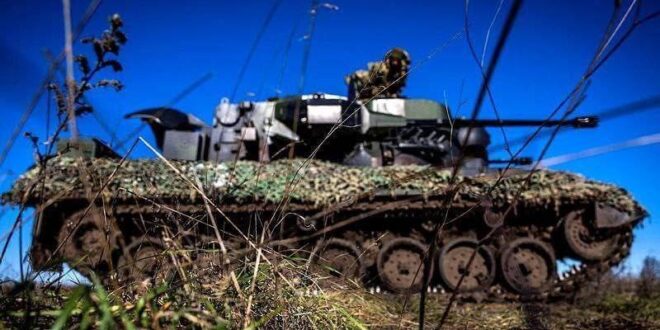Explosions are being reported in the southern city of Kherson as Ukrainian soldiers prepare for an intensified battle to return the strategic port on the west bank of the Dnipro River under their control.
Russia is increasing its evacuation of residents from the conflict zone and acknowledging the deteriorating situation in the Kherson region. At least 70,000 civilians already have been moved from Kherson, the only major city part of territories annexed by Moscow since February.
Pro-Kremlin media outlets have reported that Russian troops have moved their headquarters 50 miles to the southeast, and some have carried away bronze statues of 18th-century Russian commanders.
Commander-in-Chief of the Armed Forces of Ukraine, General Valerii Zaluzhnyi reported Friday that Russian forces have tripled the intensity of hostilities in certain sections of the front, with up to 80 daily assaults. The Ukrainian General Staff reported that Russian forces are currently focusing those offensive operations in the direction of Bakhmut, Avdiivka, and western Donetsk region.
However, Russia’s “newly mobilized conscripts likely have minimal training or no training at all,” Britain’s Defense Ministry said Saturday in its intelligence update.
The report said that “Russia is probably struggling to provide military training for its current mobilization drive and its annual autumn conscription intake. The Russian Armed Forces were already stretched providing training for the approximate 300,000 troops required for its partial mobilization, announced in September.
“These issues,” the ministry said, “will be compounded by the additional regular autumn annual conscription cycle” that begins in November for about 120,000 conscripts.
Russia has resorted to training troops in Belarus, the ministry said, “due to a shortage of training staff, munitions and facilities in Russa.” The intelligence update said, “Deploying forces with little or no training provides little additional offensive combat capability.”
Iranian Foreign Minister Hossein Amir Abdollahian acknowledged for the first time Saturday that Iran sent drones to Russia, but he said that was before the Russian invasion of Ukraine, where Russia has been using drones to target power stations and civilian infrastructure.
The U.S. and its Western allies on the U.N. Security Council have called on Secretary-General Antonio Guterres to investigate whether Russia has used Iranian drones to attack civilians in Ukraine.
New US aid package
Meanwhile, the U.S. is providing about $400 million in additional security assistance to Ukraine as the fight against Russia’s invasion enters its ninth month.
The U.S. Defense Department said in a statement that the latest package “underscores the continued U.S. commitment to supporting Ukraine by meeting their most urgent needs, while also building the capacity of Ukraine’s Armed Forces to defend its sovereignty over the long term.”
The U.S. now has committed more than $18.2 billion to Ukraine since the beginning “of Russia’s unprovoked and brutal invasion February 24,” the statement read.
The U.S. military assistance includes refurbishing HAWK air defense missiles, funding for 45 refurbished T-72B tanks with advanced optics, communications, and armor packages, 1,100 Phoenix Ghost tactical unmanned aerial systems, 40 armored riverine command boats, funding to refurbish 250 M1117 armored security vehicles, as well as tactical secure communications systems and surveillance systems, along with funding for training, maintenance, and sustainment.
In his nightly address Friday, Ukrainian President Volodymyr Zelenskyy thanked the United States for its latest military assistance and said it is the armored vehicles in particular that “we very much need to move forward at the front.”
“I am grateful to President Biden, the U.S. Congress and the entire American people for the continued and vital assistance,” he said.
Earlier Friday, Jake Sullivan, the White House national security adviser, said during a visit to Kyiv that U.S. support for Ukraine would remain “unwavering and unflinching” following next Tuesday’s midterm congressional elections.
“We fully intend to ensure that the resources are there as necessary, and that we’ll get votes from both sides of the aisle to make that happen,” Sullivan told reporters during a briefing at the Ukrainian presidential administration.
Some Republicans have indicated they would try to scale back U.S. aid to Kyiv if they win control of the U.S. Congress in the November 8 elections. Last month, Kevin McCarthy, the top Republican in the U.S. House, said Americans should not “write a blank check” for Ukraine.
Meanwhile, the Netherlands said it would spend nearly $45 million on T-72 tanks, as it cooperates with the U.S. and the Czech Republic on a shipment of 90 modernized Czech tanks. Ukraine also received the first batch of BMP-1 armored vehicles from Greece. Zelenskyy thanked Greek President Katerina Sakellaropoulou for the aid.
In an interview Friday with VOA White House Bureau Chief Patsy Widakuswara, John Kirby, the White House National Security Council Coordinator, said the U.S. “is working in lockstep with the Ukrainians.” He said officials in Washington and Kyiv talk almost daily about Ukraine’s military capabilities, what is needed and what Washington can provide for them.
Kirby said the U.S. is looking at providing more advanced capabilities to help Ukraine knock down the drones and cruise missiles the Russians are firing on civilian infrastructure.
“We are also working with allies and partners of some 40 other countries [who] are contributing security assistance to Ukraine. France, Spain, [and] Germany have been real big contributors with respect to providing some additional air defense capabilities,” Kirby added.
Kirby told VOA it is encouraging to hear that Russians do not want a nuclear exchange.
“We hope that they actually mean that, because we agree that a nuclear war should never be fought. It certainly can’t be won,” he said. But, he added, Washington is “judging them” not by what they are saying but by what they are doing on the ground.
He was referring to Putin’s mobilization of more than 300,000 reservists and Moscow’s “sham referendum” in Ukraine to politically annex ground it could not occupy militarily, as well as to Russia seeking help from countries like Iran and North Korea.
 Eurasia Press & News
Eurasia Press & News



